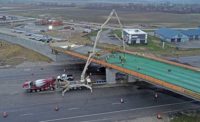Indiana DOT Seeks P3 for I-69 Project


Spending private money to fund infrastructure is nothing new to Indiana, whose Interstate 69 project through the state's southwestern quadrant is called the largest all-new federal highway under construction in the U.S. Four years after its groundbreaking, nearly half of the 142-mile-long stretch opened in November. It was funded in part by a $3.8-billion lease of the Indiana Toll Road in 2006. As the project moves into its next phase, the Indiana Dept. of Transportation is again looking for private investors.
The future of I-69—a long-planned shipping corridor between Texas and Michigan that would ultimately link Mexico and Canada—is getting brighter even as states grapple with massive budget challenges. Indiana has closed a sizable gap in the route, with $1 billion of construction finished or pending on the planned stretch from Evansvillle to Indianapolis. The state's total share is estimated to reach $2 billion.
Breaking ground under Indiana Gov. Mitch Daniels (R), who signed the toll- road concession, the I-69 corridor through Indiana has been planned for years. The state's newly elected governor, Mike Pence (R), says he will finish the job. Last month, INDOT put out a request for information (RFI) seeking public-private partnerships (P3s) to develop Section 5, a 23-mile segment between Bloomington and Martinsville. Construction would cost $350 million to $500 million, according to the RFI. A sixth leg, from Martinsville to Indianapolis, would complete the road but was not in the RFI's scope.
Early signs are encouraging. The state received 17 responses from "regional, national and international firms with extensive expertise in the design, construction and financing of large public infrastructure projects," says Will Wingfield, INDOT spokesman. Bidders are not allowed to use tolls for financing. "Many people think that P3s will instantly lead to tolling," says Wingfield. "We have committed that motorists will be able to drive from Evansville to Indianapolis without paying a toll."
The RFI seeks design-build-finance and design-build-finance-operate-maintain proposals. After reviewing the responses, the state says it will publish a request for qualifications as early as next month, with a final request for proposals in July and an award in October. Late last year, Indiana and Kentucky awarded an international P3 design-build team, led by Chicago-based Walsh Group, a job to build twin 2,500-ft-long bridges across the Ohio River into Louisville.
So far, INDOT has finished 67 miles of the four-lane I-69 at a cost of $620 million. In November, it opened the three-section stretch, from Evansville to Crane, which is home to a large Navy base. Section 4, a 27-mile link between Crane and Bloomington, where Indiana University is located, is under construction at an estimated cost of about $400 million. Sections 5 and 6, still in review, would lead to Indianapolis, where an existing stretch of I-69 takes traffic through Port Huron, Mich., and into Canada.
Proponents of I-69 call it an important economic driver for the state, especially in an area of Indiana that lacks direct routes to major cities. "That is a part of the state that's never been well served for transportation," explains Sandra Flum, INDOT project manager. Meanwhile, the project has survived challenges against such issues as land acquisition, environmental impact and road alignment. In an effort to gain influence, INDOT has held "kitchen table" meetings with landowners. The tactic, which so far has resulted in a 94% success rate, has been recognized by national engineering groups.
Material Differences
Designed for 70-mph travel speeds, typical road sections along I-69 include two 12-ft-wide travel lanes in each direction, 10-ft outside shoulders, 4-ft inside shoulders and a 60-ft-wide depressed median. The typical concrete pavement is 10.5 in. thick on 9 in. of aggregate. The typical hot-mix-asphalt profile is roughly 13 in.
INDOT has asked contractors to bid on either pavement using a life-cycle cost analysis, which projects a net-present value over the road's life. Only in geologically sensitive locations does the owner specify asphalt. So far, INDOT officials estimate that 75% of the new road has been paved with concrete. However, asphalt prices are starting to become more competitive as the economy rebounds.


